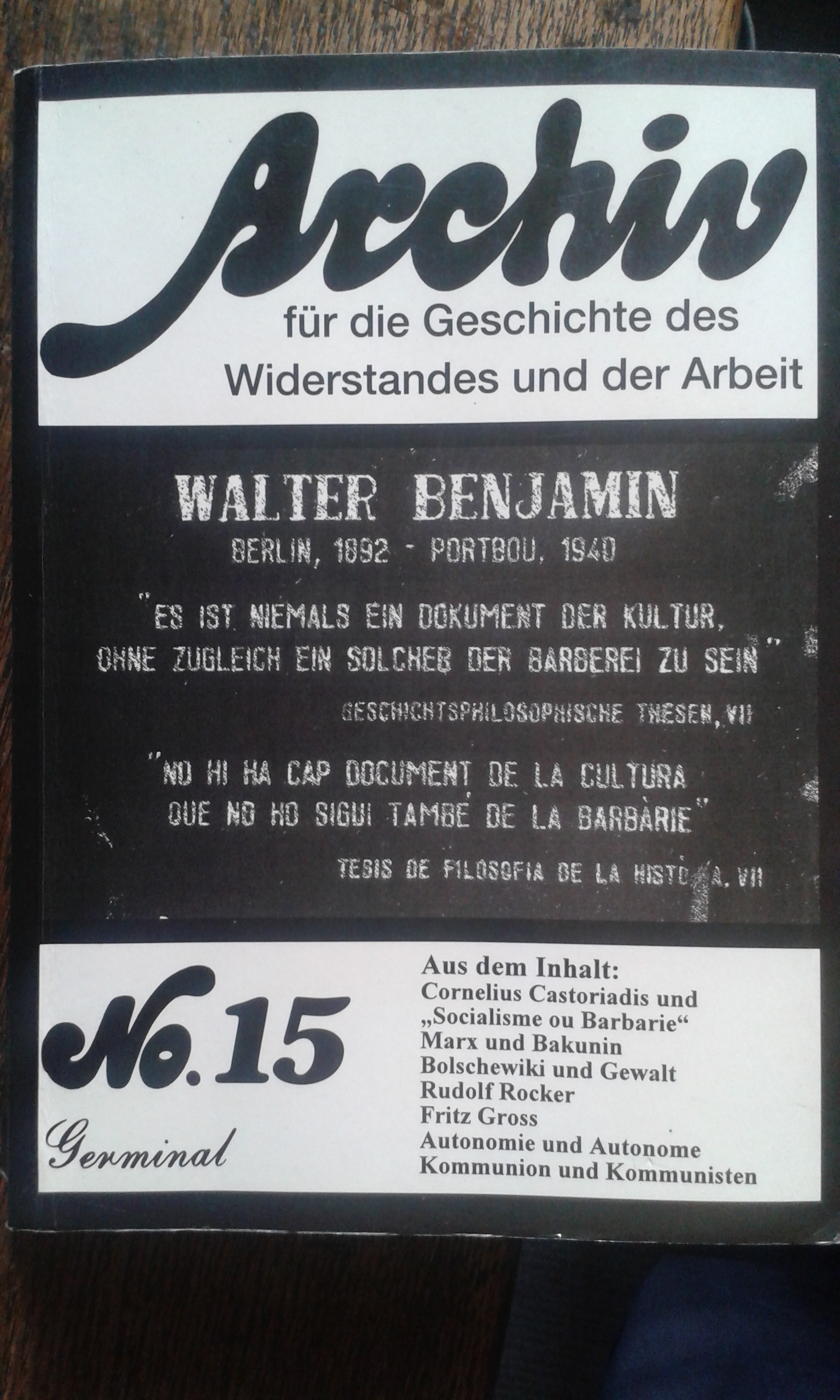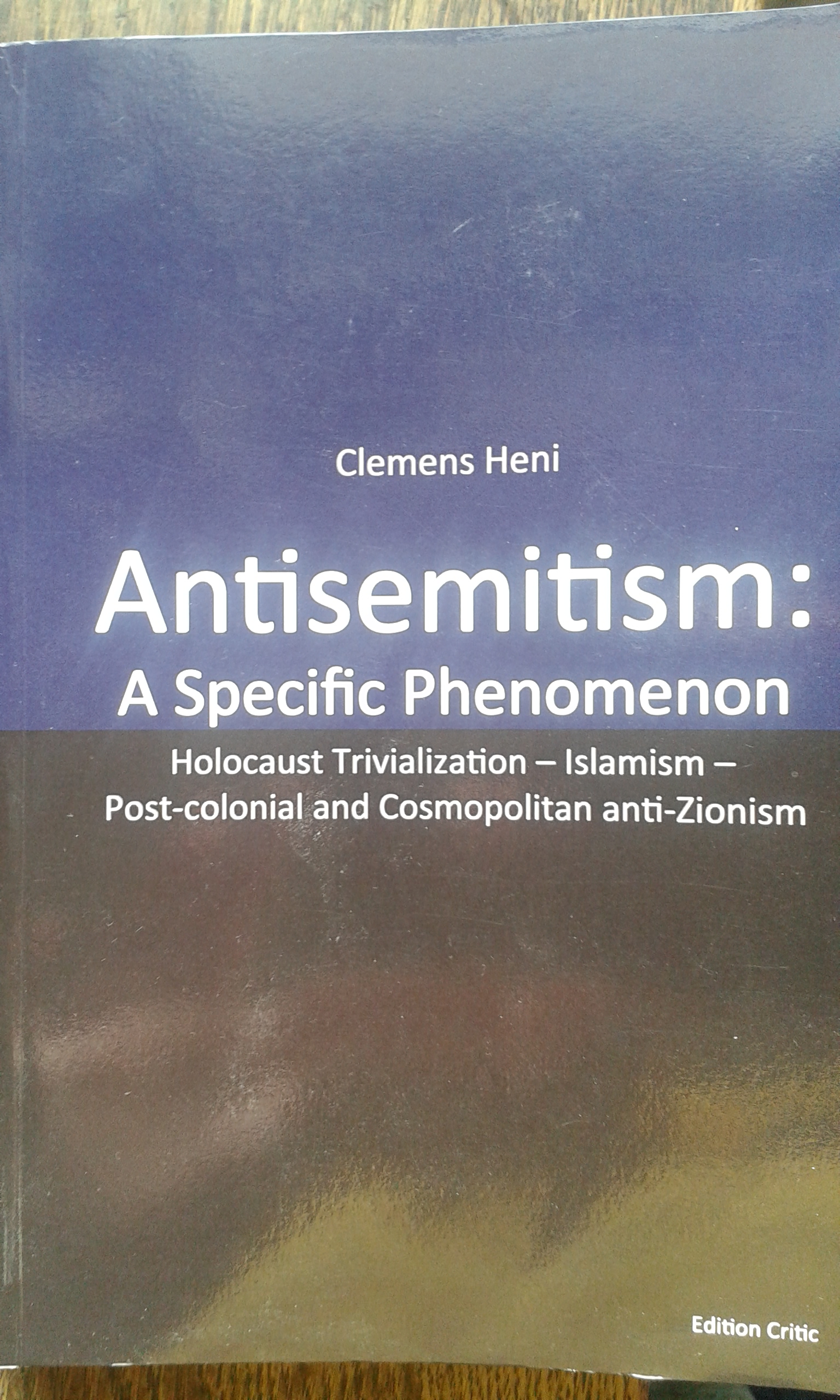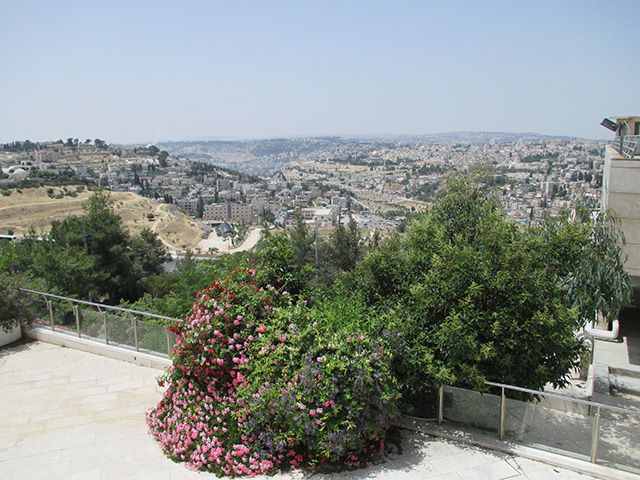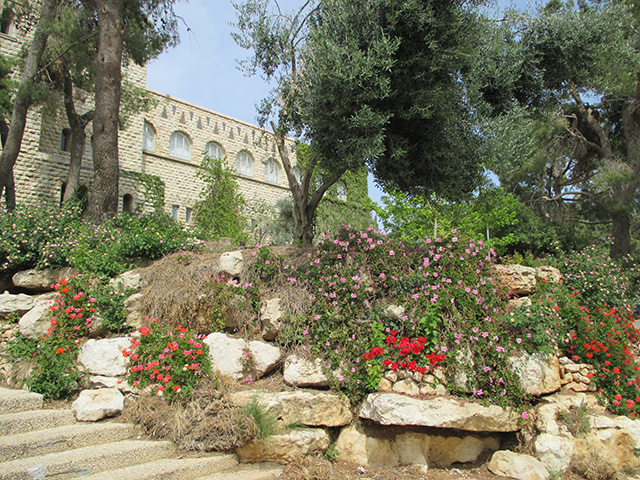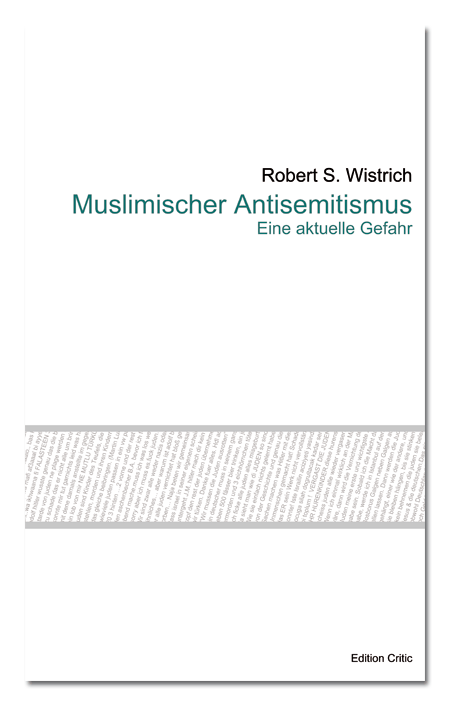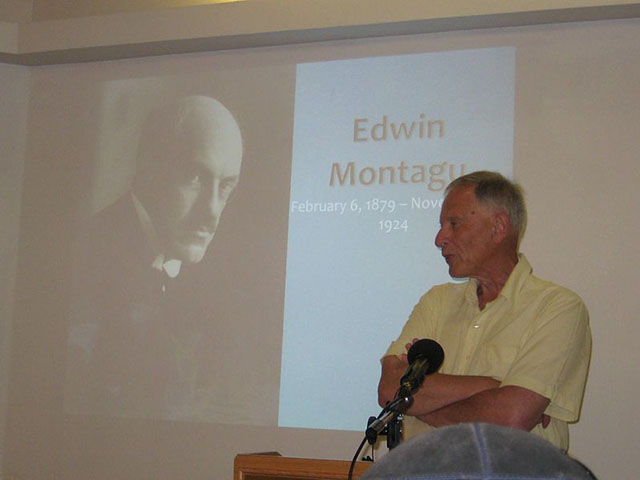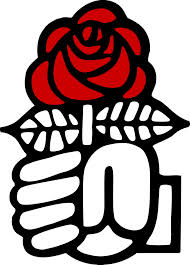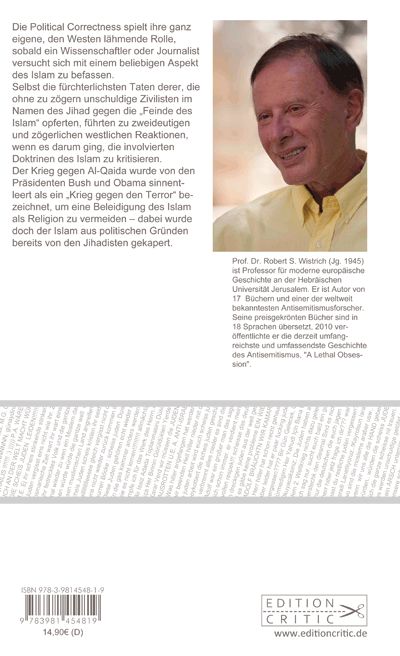Für Karl-Hans
Wenn selbst „Linke“, die früher einmal das Spezifische an den deutschen Verbrechen zu erkennen in der Lage waren und dafür vom Mainstream wie dem Zentrum für Antisemitismusforschung an der TU Berlin Ende der 1990er Jahre gedisst wurden, heute nun voll auf „Kurs“ sind und die Shoah im Orkus der Geschichte „totalitärer Regime“ in rot und braun untergehen lassen, indiziert das die gegenwärtige politische Kultur der geschwätzigen, permanent das Wort „Holocaust“ im Munde führenden Erinnerungsverweigerung an die von Deutschen begangenen präzedenzlosen Verbrechen im Nationalsozialismus.
Der Soziologe Helmut Dahmer, der bei Adorno und Horkheimer in Frankfurt studierte und der u.a. durch eine Lektüre von Freud und Marx in den 1970er Jahren ein typischer Vertreter der Neuen Linken war, schrieb noch 1998:
»Nicht die in Tätern, Mittätern und Sympathisanten wirksame antisemitische Disposition ermöglichte die ›Implementierung des Holocaust‹, sondern das, was Goldhagen sich weigert, ›erkennen zu wollen‹: die ›Mischung von ideologischem Fanatismus, psychopathologischer Verirrung, moralischer Indifferenz und bürokratischem Perfektionismus, eben (die) ›Banalität des Bösen‹. Diese wissenschaftliche Erklärung der ›Ursachen für den Holocaust‹, offenbar so etwas wie die Summe des derzeitigen Wissens deutscher Universitäts-Historiker, bietet den außerordentlichen Vorteil, keine zu sein. Sie ›gilt‹ für die ›Endlösung‹ wie für den Pyramidenbau, für den Albigenser-Kreuzzug wie für den Stalinschen gegen die ›Kulaken‹. Sie ist banal, weil historisch unspezifisch. Der (deutsche) Antisemitismus kommt in ihr – unter diesem Namen – gar nicht vor«.[i]
Diese Kritik an deutschen „Universitäts-Historikern“ war treffend und sie ist es noch heute. Allerdings hatte Dahmer schon damals kein Problem damit auch extrem rechte Publizisten zu zitieren wie Robert Conquest, einem Ukraine-„Experten“, der im ebenso rechten Verlag Langen-Müller 1986 das Buch „Ernte des Todes. Stalins Holocaust in der Ukraine 1929–1933“[ii] publiziert hatte. Das hatte Dahmer nicht kritisiert, wo doch die Trivialisierung der Shoah in diesem Buch, das mit einer Gleichsetzung von Buchenwald und der Situation in der Ukraine Anfang der 1930er Jahre einsetzt und es offenkundig das strategische Ziel des Verlages war, die deutsche „nationale Identität“ einzufordern, wie bereit 1978 ein im selben Verlag erschienenes Buch des Vordenkers der Neuen Rechten, Henning Eichberg, hieß, offenkundig ist.[iii] Dahmer hat mittlerweile vollends seinen Frieden mit der Umschreibung der Geschichte und der Universalisierung des Holocaust gemacht, wie es scheint, denn im August 2014 schreibt er Folgendes:
„Die heutige Ukraine hat mehr als andere Gesellschaften an der unbewältigten Erbschaft des barbarischen 20. Jahrhunderts zu tragen. Mit den baltischen Staaten, Polen und Weißrussland gehörte sie zu den – von Timothy Snyder so genannten – ‚bloodlands‘ oder ‚killing fields‘, in denen die beiden großen Menschenfresser-Regime des vorigen Jahrhunderts, das deutsche und das russische, die diese Länder untereinander aufteilten und abwechselnd besetzt hielten, ihre entsetzlichen Untaten verrichteten, die etwa 14 Millionen zivile Opfer forderten.“
Aus Hitlers willigen Vollstreckern und dem Nationalsozialismus wird also eines von mehreren „Menschenfresser-Regimen“. Kein Wort von der Spezifik der Shoah. Dieser affirmative Bezug auf Timothy Snyder und dessen weltweiten Bestseller „Bloodlands“ ist Symptom des Niedergangs kritischer Analyse und des Mainstreaming von Holocaustverharmlosung. Warum? Snyder behauptet, es hätte ein (fiktives) Territorium gegeben, das er „Bloodlands“ nennt, zwischen dem Baltikum im Norden, der Ukraine im Süden, Ostpolen im Westen und Westrussland im Osten gelegen, in dem zwischen 1932 (!) und 1945 14 Millionen ermordet worden seien. Der Holocaust und die Ermordung von sechs Millionen Juden ist nur ein Teil dieser monströsen Zahl.
Die Forschung hat Snyders These scharf kritisiert, namentlich die Historiker Dan Michman von Yad Vashem[iv], Dan Diner[v] oder Jürgen Zarusky[vi] vom Institut für Zeitgeschichte aus München. Das alles kümmert Helmut Dahmer gar nicht, er goutiert dieses obszöne und die Shoah nicht als präzedenzlos darstellende Gerede des Yale Superstars. Man muss sich nicht wundern, dass Historiker wie Michael Wildt oder Jörg Baberowski[vii] kein Problem mit Snyder haben bzw. ihn hofieren, aber bei einem Helmut Dahmer hätte man Kritik erwarten können, ja einen Schock ob der Leugnung des Präzedenzlosen, was Deutsche verbrochen haben. Dieses Goutieren, ja Promoten von „Bloodlands“, diese Bloodlandisierung der Linken und der Gesellschaft insgesamt macht diesen Text von Dahmer von 2014 so symptomatisch für unsere Zeit. Eine adäquate Erinnerung an die Shoah ist nicht mehr angesagt, und selbst ehemalige Kritiker deutscher Gedenkkultur und herkömmlicher, entlastender, den deutschen Antisemitismus diminuierenden historiographischen Ansätze im Zuge Hans Mommsens und einer ganzen Phalanx von Anti-Goldhagen-Historikern der Jahre 1996ff. stimmen heute in den revanchistischen rot=braun-Chor mit ein, und zwar lauthals. Da lacht Joachim Gauck.
Im März 2016 gibt es nun ein Porträt des Nazi-Jägers Efraim Zuroff vom Simon Wiesenthal Center im „Jerusalem Report“:
„According to Zuroff and his long-term academic colleague and Lithuania-based Yiddish scholar Dovid Katz, history in the Baltics, Ukraine, Hungary and elsewhere in the region is being rewritten to suggest equivalence between the crimes of the Nazis and the communist Soviet Union and to whitewash the role of local Nazi collaborators.“
Zuroff sagt:
„They are determined to undermine the uniqueness of the Shoah. We finally convinced the world that the Shoah was unique. Then along came the Eastern Europeans who say, ‘No, you got it all wrong. It wasn’t unique. The Shoah was terrible, but communism was just as bad.’ It is a very insidious, very sophisticated agenda. If a country has the choice between being a country of victims or a country of killers, it’s a no-brainer. Of course everyone wants to go along with this.“
Seit Jahren analysieren und kritisieren Efraim Zuroff wie auch Dovid Katz die die Shoah trivialisierenden Thesen Timothy Snyders, die Gleichsetzung von rot und braun, die Verharmlosung des Holocaust nicht nur in Osteuropa sondern durch viele Autorinnen und Autoren, AktivistInnen, PolitikerInnen oder WissenschaftlerInnen weltweit, darunter auch den deutschen Bundespräsidenten, den „Super-GAUck“, wie der „Jerusalem Report“ vom März 2016 bezüglich Efraim Zuroff festhält:
„It’s a damning allegation, but one that is rarely heard with the exception of the small minority of voices in Europe who opposed the 2008 Prague Declaration, a document that appears to legitimize many elements of the double genocide theory. It was a declaration whose individual signatories include the now president of Germany, Joachim Gauck, one-time Federal Commissioner for the Stasi archives.“
Helmut Dahmer hingegen schließt sich völlig schamlos und unumwunden Timothy Snyder an und schreibt:
„‘Das Gebiet der heutigen Ukraine war während der ganzen Epoche der Massenmorde sowohl das Zentrum der stalinistischen wie der nationalsozialistischen Mordkampagnen‘ schreibt Timothy Snyder. ‚Etwa 3.5 Millionen Menschen fielen den stalinistischen Mordmaßnahmen zwischen 1933 und 1938 zum Opfer und weitere 3.5 Millionen deutschen Mordmaßnahmen zwischen 1941 und 1944. Noch einmal rund drei Millionen Ukrainer fielen im Kampf oder starben infolge des Krieges.‘“
Damit wird jedwede Spezifik der Shoah und des eliminatorischen Antisemitismus hinweggefegt, Stalin und Hitler sind austauschbar, beide hätten analoge „Mordkampagnen“ durchgeführt. Ob der eine Auschwitz errichtete und betrieb und der andere es befreien ließ, ist völlig egal, das geht in dieser komparatistischen Obsession unter. Allein schon in der obszönen Zahlenspielerei, jeweils 3,5 Millionen Opfer werden präsentiert, wird jedwede Spezifik und Unvergleichbarkeit der Shoah negiert.
Dahmer meint, er würde damit die „Putin-Versteher“ kritisieren. Man verharmlost das autoritäre, mit Iran kungelnde, Dissidenten kaltstellende und in vielfältiger Hinsicht brutale und gefährliche Regime in Moskau nicht einen Augenblick, wenn man glasklar unterscheidet zwischen Tätern (Deutsche) und Opfern (die Sowjetunion). Die Wehrmacht griff die Sowjetunion an und nicht andersherum, die Deutschen planten die Vernichtung der europäischen Juden und, ja, Stalin war das Schicksal der Juden mehr oder weniger egal, aber de facto kämpften Rotarmisten und Rotarmistinnen gegen die SS und die Wehrmacht und befreiten Auschwitz.
Einer, der das 1998 offenbar noch wusste, war Helmut Dahmer. Heute weiß er es nicht mehr oder vernebelt frühere Erkenntnisse, er schwimmt im Mainstream der Holocausttrivialisierer, deren Stromschnellen seit Jahren der quasi Enkel von Ernst Nolte, Snyder, vorgibt.
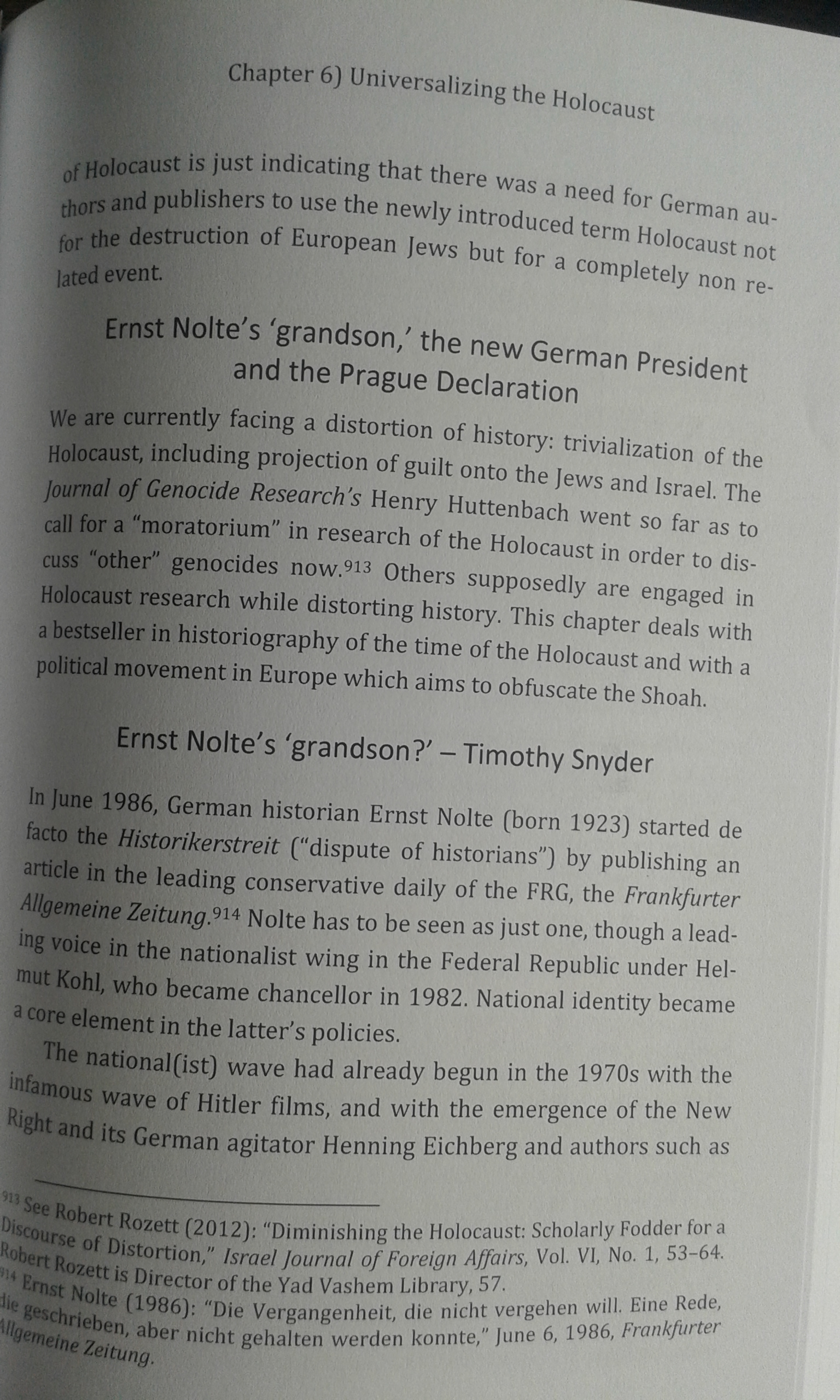 Bald werden sich womöglich wieder fast alle Bundestagsparteien unisono auf eine zweite Amtszeit jenes Ex-DDR-Pfarrers einstimmen. Und alle tanzen nach dieser Pfeife von Timothy Snyder, es ist der große Sieg des Geschichtsrevisionismus, der größte aller geschichtspolitischen Siege: nicht Auschwitz war präzedenzlos, sondern Stalin hat angefangen! Es geht um einen Zeitraum von 1932 bis 1945, so Snyder, für den die ukrainische Hungerkrise 1932 der Beginn der „Bloodlands“ ist, der viel spätere Holocaust ist da nur ein Puzzlestück unter vielen. So funktioniert heute Revisionismus. Das ist die Wiedergutwerdung der Deutschen. Es war nicht einzigartig was in Auschwitz, Sobibor und Majdanek passierte, das ist der Tenor. Irgendwie vergleichbar sei das mit Stalins Verbrechen eben schon, insinuieren der reaktionär-avantgardistische Snyder und sein Fußvolk. Das soll die Message sein, früher bei Nolte, der von der „asiatischen Tat“ redete und heute von Snyder, der von „Bloodlands“ spricht um von der industriellen Vernichtung der Juden zu schweigen und sie zu trivialisieren. Und diese Rede von rot=braun gibt es eben schon lange nicht mehr nur bei der FAZ oder der Springer-Presse (die natürlich, Herbert Marcuse lässt grüßen, auch mal anderslautende Texte publiziert, „repressive Toleranz 2.0“), sondern auch im Bundespräsidialamt oder „Linken“. Für die nationale Identität der Deutschen ist es eine Grundvoraussetzung, die deutschen Verbrechen am allerbesten nicht vollends zu leugnen, sondern diesen dreckigen Job der Nazis durch Komparatistik mainstreammäßig zu machen und zu adeln. Martin Walsers antisemitische Erinnerungsabwehr von 1998 in seiner Paulskirchenrede wird durch die Ideologie des rot=braun ergänzt und flankiert.
Bald werden sich womöglich wieder fast alle Bundestagsparteien unisono auf eine zweite Amtszeit jenes Ex-DDR-Pfarrers einstimmen. Und alle tanzen nach dieser Pfeife von Timothy Snyder, es ist der große Sieg des Geschichtsrevisionismus, der größte aller geschichtspolitischen Siege: nicht Auschwitz war präzedenzlos, sondern Stalin hat angefangen! Es geht um einen Zeitraum von 1932 bis 1945, so Snyder, für den die ukrainische Hungerkrise 1932 der Beginn der „Bloodlands“ ist, der viel spätere Holocaust ist da nur ein Puzzlestück unter vielen. So funktioniert heute Revisionismus. Das ist die Wiedergutwerdung der Deutschen. Es war nicht einzigartig was in Auschwitz, Sobibor und Majdanek passierte, das ist der Tenor. Irgendwie vergleichbar sei das mit Stalins Verbrechen eben schon, insinuieren der reaktionär-avantgardistische Snyder und sein Fußvolk. Das soll die Message sein, früher bei Nolte, der von der „asiatischen Tat“ redete und heute von Snyder, der von „Bloodlands“ spricht um von der industriellen Vernichtung der Juden zu schweigen und sie zu trivialisieren. Und diese Rede von rot=braun gibt es eben schon lange nicht mehr nur bei der FAZ oder der Springer-Presse (die natürlich, Herbert Marcuse lässt grüßen, auch mal anderslautende Texte publiziert, „repressive Toleranz 2.0“), sondern auch im Bundespräsidialamt oder „Linken“. Für die nationale Identität der Deutschen ist es eine Grundvoraussetzung, die deutschen Verbrechen am allerbesten nicht vollends zu leugnen, sondern diesen dreckigen Job der Nazis durch Komparatistik mainstreammäßig zu machen und zu adeln. Martin Walsers antisemitische Erinnerungsabwehr von 1998 in seiner Paulskirchenrede wird durch die Ideologie des rot=braun ergänzt und flankiert.
Und wer sich ein bisschen mit den Moden der Sozial- und Geisteswissenschaften auskennt, weiß wie angesagt diese Holocaustvergleiche in der Geschichtswissenschaft, dem Postkolonialismus, der vergleichenden Literaturwissenschaft, der „Genozidforschung“ oder der Islamforschung („Muslime als die neuen Juden“ etc.), der transnationalen Forschung[viii], welche den Holocaust gerade nicht als spezifisch deutsches, von Deutschland geplantes (aber auch mit Hilfe zumal osteuropäischer Einheiten durchgeführten), sondern europäisches Phänomen betrachtet, und vieler weiterer Felder sind. Spätestens seit 1949 und Heideggers Bremer Vorträge ist die Universalisierung des Holocaust der Topos vieler Deutscher, die Schuld abwehren und das deutsche Verbrechen entspezifizieren, ja universalisieren.[ix]
Pegida ist übrigens auch eine Bewegung der Holocausttrivialisierung, was kaum jemand je analysiert hat, da sie auf ihrem Logo Hakenkreuz und Sowjetstern bzw. die Antifa (und den Islam) gleichsetzen.

Diese Gleichsetzung von rot und braun findet man auch in Museen in Estland:
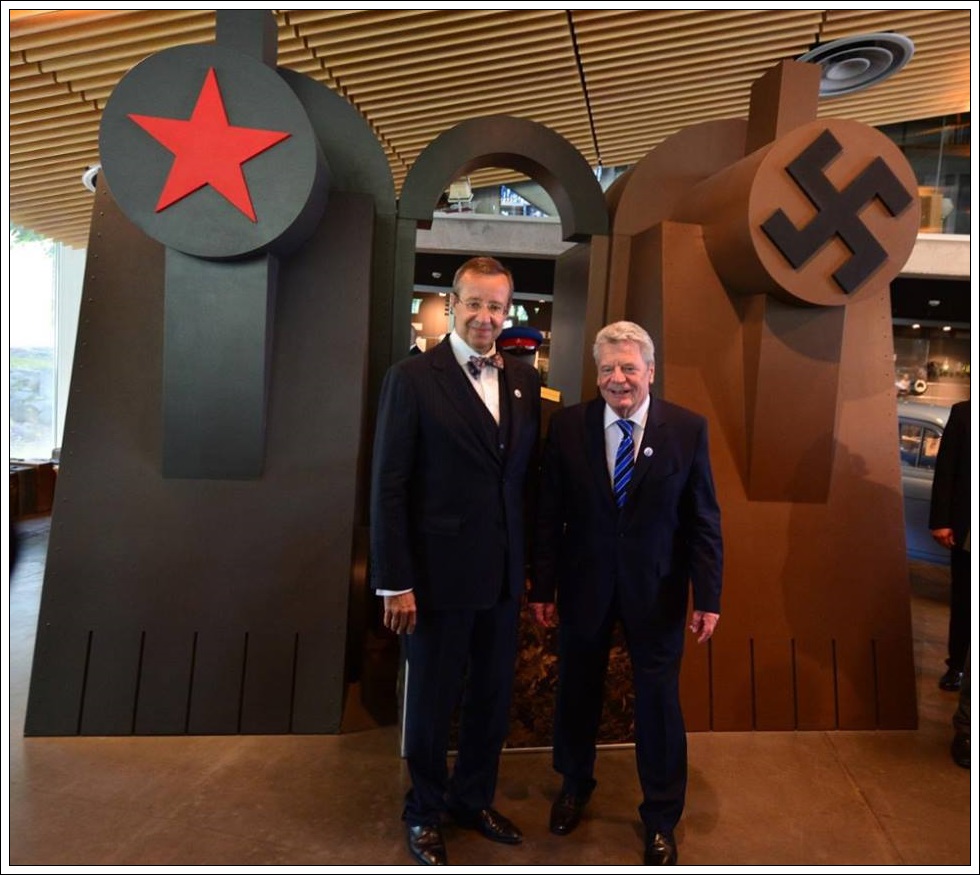
Israelfeinde vergleichen den Judenstaat mit Nazis, eine Taktik, die man mitunter auch bei Publikationen gewisser Zentren für jüdische Studien sehen kann, wie noch zu zeigen sein wird in diesem Jahr. Das ist die widerwärtigste Form von Antisemitismus, eine Trivialisierung der deutschen Verbrechen, eine Schuldprojektion und die Verkehrung von Opfer und Täter. Doch nicht weniger beliebt ist der rot=braun-Reflex und die Trivialisierung der deutschen Verbrechen und das nicht nur bei Konservativen und Stolzdeutschen, sondern selbst bei Leuten, die noch vor gar nicht so vielen Jahren solcher unwissenschaftlichen und politisch reaktionären Rede unverdächtig waren. So ändert sich die politische Kultur dieses Landes. Und niemand fällt es auf, da selbst die wenigen Kritiker des Antisemitismus immer „nur“ den antizionistischen im Blick haben, aber bei der Analyse der Holocaustverharmlosung kläglich versagen.
Nicht nur deshalb sind Stimmen wie die von Efraim Zuroff so unsagbar wertvoll.
[i] Helmut Dahmer (1998): Holocaust und Geschichtsschreibung. Nachlese zur Goldhagen-Kontroverse, in: Archiv für die Geschichte des Widerstands und der Arbeit, Nr. 15, Fernwald (Annerod), S. 441–462, hier S. 456. Dieser Artikel von Dahmer wurde bezeichnenderweise deshalb von Heil/Erb als Beitrag für den von diesen konzipierten Sammelband (Johannes Heil/Rainier Erb (Hg.) (1998): Geschichtswissenschaft und Öffentlichkeit. Der Streit um Daniel J. Goldhagen, Frankfurt a. M.: Fischer Taschenbuch) abgelehnt, weil sie keinen »Band nach Pro-Contra-Muster« wollten (ebd.: 441).
[ii] Robert Conquest (1988): Ernte des Todes. Stalins Holocaust in der Ukraine 1929–1933, München: Langen-Müller (erste Auflage 1986).
[iii] Henning Eichberg (1978): Nationale Identität. Entfremdung und nationale Frage in der Industriegesellschaft, München/Wien: Langen-Müller.
[iv] Dan Michman (2012): “Bloodlands and the Holocaust: Some Reflections on Terminology, Conceptualization and their Consequences,” ich beziehe mich auf das Manuskript, das mir der Verfasser vor der Publikation im Journal of Modern European History schickte.
[v] Dan Diner (2012): “Topography of Interpretation: Reviewing Timothy Snyder’s Bloodlands,” Contemporary European History, Vol. 21, No. 2, 125–131; Dan Diner (2012a): “An Auschwitz vorbei. Timothy Snyder erhält für sein Buch ‘Bloodlands’ den diesjährigen Leipziger Buchpreis. Zu Recht? Jedenfalls weist seine angeblich wegweisende Arbeit Mängel auf“, 17. März 2012, http://www.welt.de/print/die_welt/vermischtes/article13927362/An-Auschwitz-vorbei.html (eingesehen am 4. März 2016).
[vi] Jürgen Zarusky (2012): “Timothy Snyders „Bloodlands“. Kritische Anmerkungen zur Konstruktion einer Geschichtslandschaft“, Vierteljahreshefte für Zeitgeschichte, 60. Jg., Nr. 1, 1–31.
[vii] Michael Wildt (2012): “Ist der Holocaust nicht mehr beispiellos? Neue Forschungen zu Stalin und Shoah“, Süddeutsche Zeitung, May 23, 2012, http://www.sueddeutsche.de/kultur/neue-forschungen-zu-stalin-und-shoah-ist-der-holocaust-nicht-mehr-beispiellos-1.1364122 (eingesehen am 4. März 2016); Jörg Baberowski (2012): “Once and for all: The encounter between Stalinism and Nazism. Critical remarks on Timothy Snyder’s Bloodlands,” Contemporary European History, Vol. 21, No. 2, 145–148.
[viii] Siehe nur den höchst problematischen Text von Peter Fritzsche (2009): “Holocaust,” in: Akira Iriye/Pierre-Yves Saunier (Hg.), The Palgrave Dictionary of Transnational History, Basingstoke: Palgrave Macmillan, 499–500.
[ix] Martin Heidegger (1949): “Einblick in Das Was Ist”, in: Martin Heidegger (1949a), Bremer und Freiburger Vorträge, Frankfurt: Vittorio Klostermann, Gesammelte Werkte, Band 79, 3–77, 27: „Ackerbau ist jetzt motorisierte Ernährungsindustrie, im Wesen das Selbe wie die Fabrikation von Leichen in Gaskammern und Vernichtungslagern, das Selbe wie die Blockade und Aushungerung von Ländern, das Selbe wie die Fabrikation von Wasserstoffbomben.“


